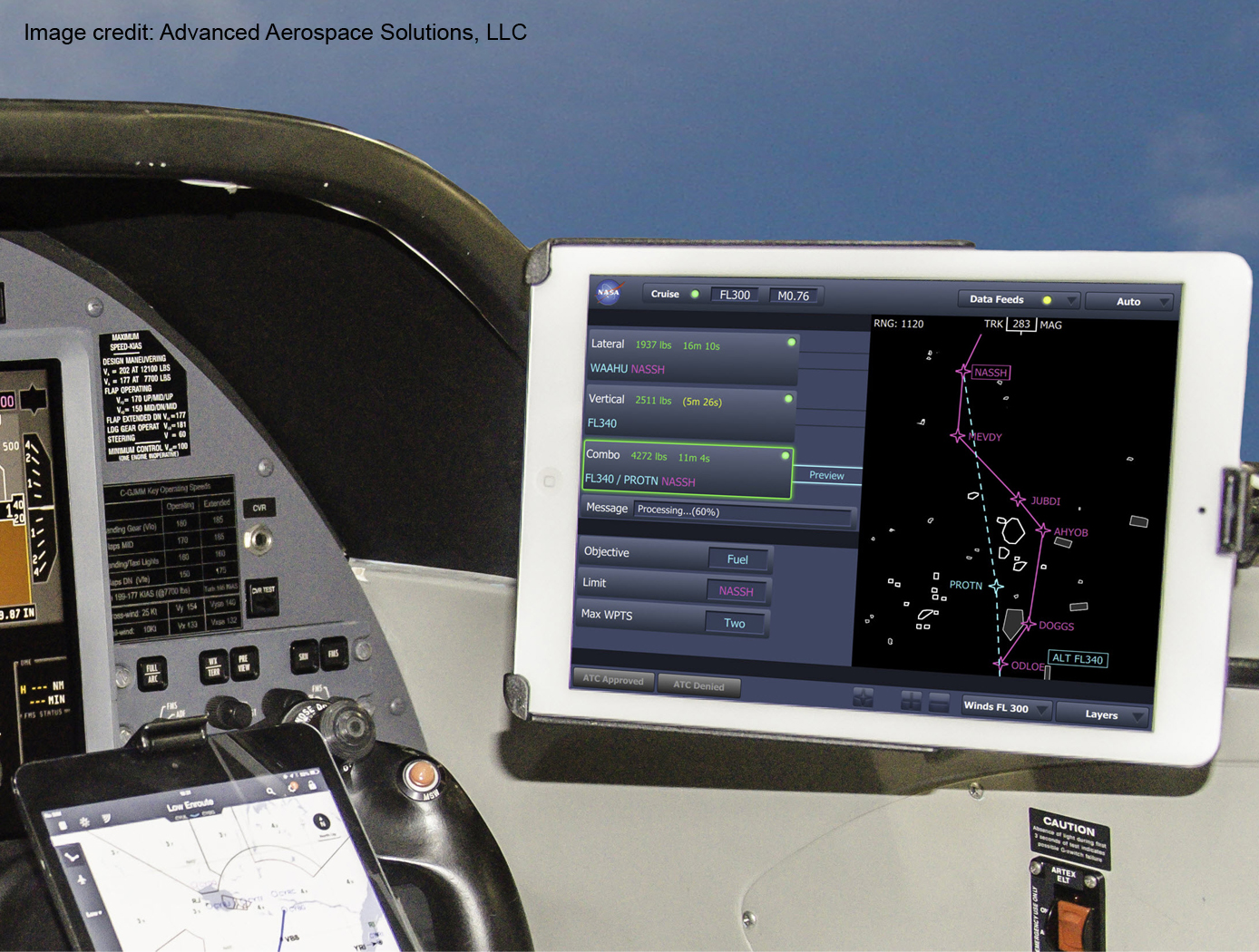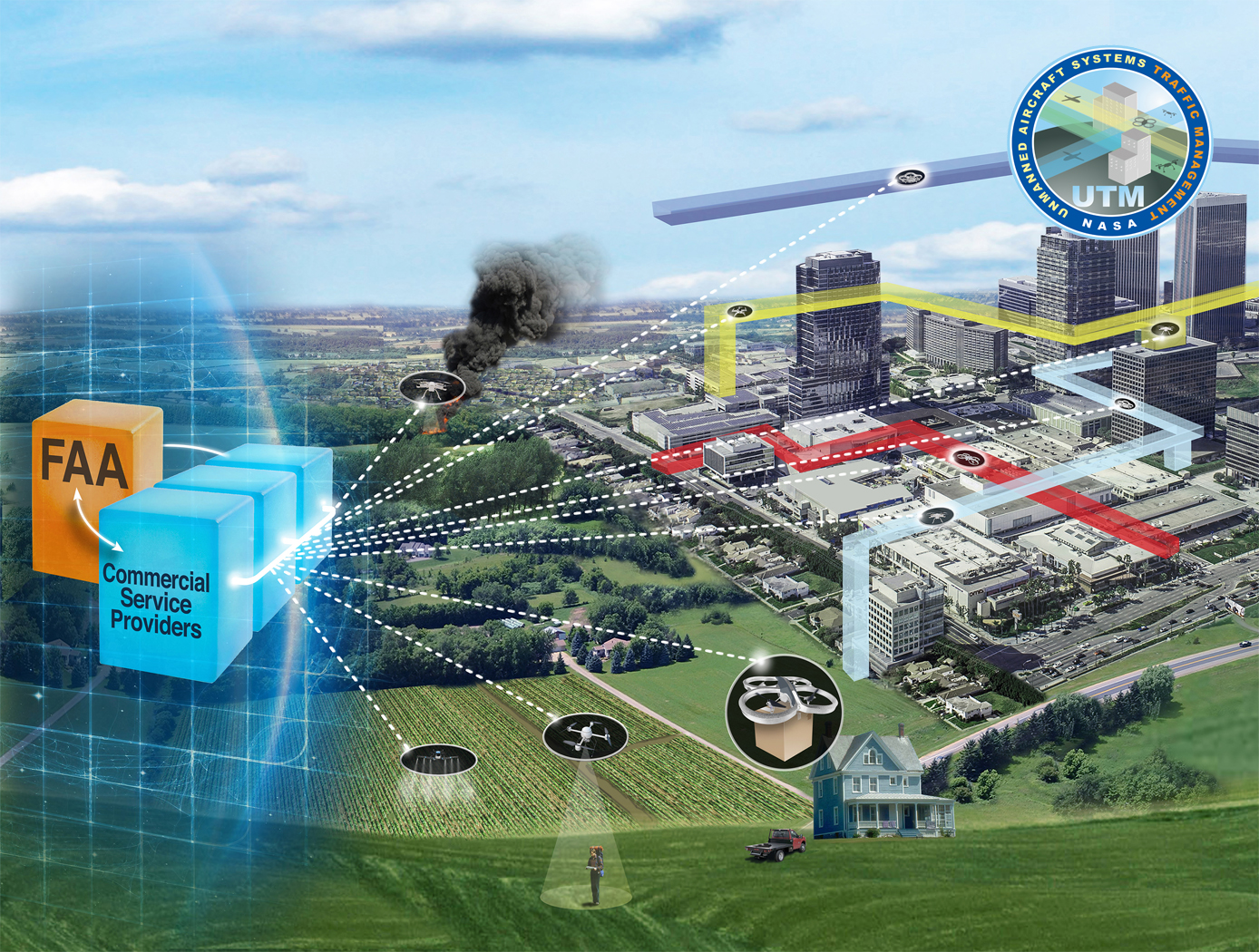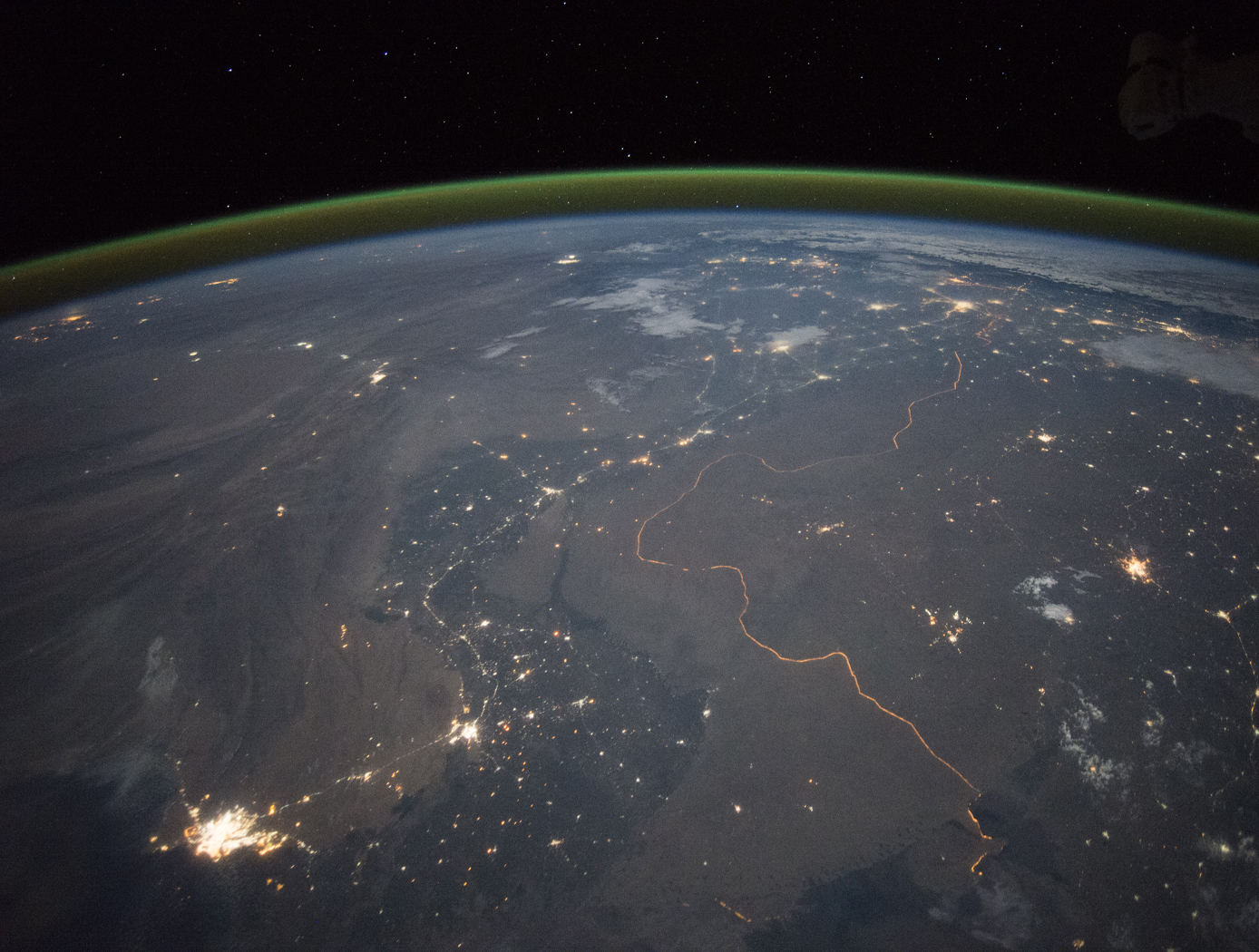Search
PATENT PORTFOLIO
Information Technology and Software
NASA develops information technology and software to support a wide range of activities, including mission planning and operations, data analysis and visualization, and communication and collaboration. These technologies also play a key role in the development of advanced scientific instruments and spacecraft, as well as in the management of NASA's complex organizational and technical systems. By leveraging NASA's advances in IT and software, your business can gain a competitive edge.

Space Traffic Management (STM) Architecture
As ever larger numbers of spacecraft seek to make use of Earth's limited orbital volume in increasingly dense orbital regimes, greater coordination becomes necessary to ensure these spacecraft are able to operate safely while avoiding physical collisions, radio-frequency interference, and other hazards. While efforts to date have focused on improving Space Situational Awareness (SSA) and enabling operator to operator coordination, there is growing recognition that a broader system for Space Traffic Management (STM) is necessary. The STM architecture forms the framework for an STM ecosystem, which enables the addition of third parties that can identify and fill niches by providing new, useful services. By making the STM functions available as services, the architecture reduces the amount of expertise that must be available internally within a particular organization, thereby reducing the barriers to operating in space and providing participants with the information necessary to behave responsibly. Operational support for collision avoidance, separation, etc., is managed through a decentralized architecture, rather than via a single centralized government-administered system.
The STM system is based on the use of standardized Application Programming Interfaces (API) to allow easier interconnection and conceptual definition of roles to more easily allow suppliers with different capabilities to add value to the ecosystem. The architecture handles basic functions including registration, discovery, authentication of participants, and auditable tracking of data provenance and integrity. The technology is able to integrate data from multiple sources.

Computer Vision Lends Precision to Robotic Grappling
The goal of this computer vision software is to take the guesswork out of grapple operations aboard the ISS by providing a robotic arm operator with real-time pose estimation of the grapple fixtures relative to the robotic arms end effectors. To solve this Perspective-n-Point challenge, the software uses computer vision algorithms to determine alignment solutions between the position of the camera eyepoint with the position of the end effector as the borescope camera sensors are typically located several centimeters from their respective end effector grasping mechanisms.
The software includes a machine learning component that uses a trained regional Convolutional Neural Network (r-CNN) to provide the capability to analyze a live camera feed to determine ISS fixture targets a robotic arm operator can interact with on orbit. This feature is intended to increase the grappling operational range of ISSs main robotic arm from a previous maximum of 0.5 meters for certain target types, to greater than 1.5 meters, while significantly reducing computation times for grasping operations.
Industrial automation and robotics applications that rely on computer vision solutions may find value in this softwares capabilities. A wide range of emerging terrestrial robotic applications, outside of controlled environments, may also find value in the dynamic object recognition and state determination capabilities of this technology as successfully demonstrated by NASA on-orbit.
This computer vision software is at a technology readiness level (TRL) 6, (system/sub-system model or prototype demonstration in an operational environment.), and the software is now available to license. Please note that NASA does not manufacture products itself for commercial sale.

Traffic Aware Strategic Aircrew Requests (TASAR)
The NASA software application developed under the TASAR project is called the Traffic Aware Planner (TAP). TAP automatically monitors for flight optimization opportunities in the form of lateral and/or vertical trajectory changes. Surveillance data of nearby aircraft, using ADS-B IN technology, are processed to evaluate and avoid possible conflicts resulting from requested changes in the trajectory. TAP also leverages real-time connectivity to external information sources, if available, of operational data relating to winds, weather, restricted airspace, etc., to produce the most acceptable and beneficial trajectory-change solutions available at the time. The software application is designed for installation on low-cost Electronic Flight Bags that provide read-only access to avionics data. The user interface is also compatible with the popular iPad. FAA certification and operational approval requirements are expected to be minimal for this non-safety-critical flight-efficiency application, reducing implementation cost and accelerating adoption by the airspace user community.
Awarded "2016 NASA Software of the Year"

Selective Access and Editing in a Database
A complex project has many tasks and sub-tasks, many phases and many collaborators, and will often have an associated database with many users, each of which has a limited need to know that does not extend to all information in the database. This invention relates to selective access to simultaneous editing of different portions of a database. It provides selective access to as many as 2N-1 (or 2N) mutually exclusive portions of a database by different subgroups of N users. One or more members of an access subgroup can edit a document or other information collection, to which the members have access simultaneously. In this system the database receives information from one or more information sources and is queried by a plurality of users. The database permits selective access of a given user to different portions of the database, depending upon the users identity and access permissions. Optionally, members of the same access subgroup can be assigned different numerical priorities in a queue so that, as between first and second users in the subgroup, draft editing of a document by the first user will subsequently be reviewed, declined, or either partly entered or wholly entered by the second user. User access to different portions of the database is initially determined when a user account is set up. User access can be subsequently changed according to the circumstances.

Near-Real Time Verification and Validation of Autonomous Flight Operations
NASA's Extensible Traffic Management (xTM) system allows for distributed management of the airspace where disparate entities collaborate to maintain a safe and accessible environment. This digital ecosystem relies on a common data generation and transfer framework enabled by well-defined data collection requirements, algorithms, protocols, and Application Programming Interfaces (APIs). The key components in this new paradigm are:
Data Standardization: Defines the list of data attributes/variables that are required to inform and safely perform the intended missions and operations.
Automated Real Time And/or Post-Flight Data Verification Process: Verifies system criteria, specifications, and data quality requirements using predefined, rule-based, or human-in-the-loop verification.
Autonomous Evolving Real Time And/or Post-Flight Data Validation Process: Validates data integrity, quantity, and quality for audit, oversight, and optimization.
The verification and validation process determines whether an operation’s performance, conformance, and compliance are within known variation. The technology can verify thousands of flight operations in near-real time or post flight in the span of a few minutes, depending on networking and computing capacity. In contrast, manual processing would have required hours, if not days, for a team of 2-3 experts to review an individual flight.

Real-Time, High-Resolution Terrain Information in Computing-Constrained Environments
NASA Armstrong collaborated with the U.S. Air Force to develop algorithms that interpret highly encoded large area terrain maps with geographically user-defined error tolerances. A key feature of the software is its ability to locally decode and render DTMs in real time for a high-performance airplane that may need automatic course correction due to unexpected and dynamic events. Armstrong researchers are integrating the algorithms into a Global Elevation Data Adaptive Compression System (GEDACS) software package, which will enable customized maps from a variety of data sources.
How It Works
The DTM software achieves its high performance encoding and decoding processes using a unique combination of regular and semi-regular geometric tiling for optimal rendering of a requested map. This tiling allows the software to retain important slope information and continuously and accurately represent the terrain. Maps and decoding logic are integrated into an aircraft's existing onboard computing environment and can operate on a mobile device, an EFB, or flight control and avionics computer systems. Users can adjust the DTM encoding routines and error tolerances to suit evolving platform and mission requirements. Maps can be tailored to flight profiles of a wide range of aircraft, including fighter jets, UAVs, and general aviation aircraft.
The DTM and GEDACS software enable the encoding of global digital terrain data into a file size small enough to fit onto a tablet or other handheld/mobile device for next-generation ground collision avoidance. With improved digital terrain data, aircraft could attain better performance. The system monitors the ground approach and an aircraft's ability to maneuver by predicting several multidirectional escape trajectories, a feature that will be particularly advantageous to general aviation aircraft.
Why It Is Better
Conventional DTM encoding techniques used aboard high-performance aircraft typically achieve relatively low encoding process ratios. Also, the computational complexity of the decoding process can be high, making them unsuitable for the real-time constrained computing environments of high-performance aircraft. Implementation costs are also often prohibitive for general aviation aircraft. This software achieves its high encoding process ratio by intelligently interpreting its maps rather than requiring absolute retention of all data. For example, the DTM software notes the perimeter and depth of a mining pit but ignores contours that are irrelevant based on the climb and turn performance of a particular aircraft and therefore does not waste valuable computational resources. Through this type of intelligent processing, the software eliminates the need to maintain absolute retention of all data and achieves a much higher encoding process ratio than conventional terrain-mapping software. The resulting exceptional encoding process allows users to store a larger library of DTMs in one place, enabling comprehensive map coverage at all times. Additionally, the ability to selectively tailor resolution enables high-fidelity sections of terrain data to be incorporated seamlessly into a map.

STELLA-1.2
The STELLA-1.2 base unit includes a microcontroller, GPS, BME280 (temperature, pressure, humidity), and rotary control with display. Sensor modules include:
• Spectrometer: 18-band VNIR from 410–940nm, UV, light, IR, lidar
• Air Quality: CO₂ (SCD-40), PM2.5/PM10 (PMSA003I), methane
• Expandability: More modules via magnetic couplers and CircuitPython menu additions

Integrated Genomic and Proteomic Information Security Protocol
NASA GSFC has developed a cybersecurity security protocol consisting of message exchanges utilizing message authentication codes and encryption codes derived from the genetic encoding system for key generation, Proteins and the processes of transcription and translation of DNA and RNA into proteins. These are used in conjunction with the existing principles of a public key infrastructure and traditional encryption and authentication algorithms and processes. This security protocol requires a cryptanalysis infrastructure not available to most attackers. By using the processes of transcription and translation of actual genes (referred to as biogenes) in conjunction with a genomic and proteomic based encryption and authentication approach, security is achieved in two simultaneous domains. An attacker has to successfully breach both domains simultaneously for successful network attack.

First Stage Bootloader
The First Stage Bootloader reads software images from flash memory, utilizing redundant copies of the images, and launches the operating system. This bootloader finds a valid copy of the OS image and the ram filesystem image in flash memory. If none of the copies are fully valid, the bootloader attempts to construct a fully valid image by validating the images in small sections and piecing together validated sections from multiple copies.
Periodically, throughout this process, the First Stage Bootloader restarts the watchdog timer.
The First Stage Bootloader reads a boot table from a default location in flash memory. This boot table describes where to find the OS image and its supporting ram filesystem image in flash. It uses header information and a checksum to validate the table. If the table is corrupt, it reads the next copy until it finds a valid table. There can be many copies of the table in flash, and all will be read if necessary. The First Stage Bootloader reads the ram filesystem image into memory and validates its contents. Similar to the boot table, if one copy of the image is corrupt, it will read the remaining copies until it finds one with a valid header. If it doesn't find a valid copy, it will break the image down into smaller portions. For each section, it checks each copy until it finds a valid copy of the section and copies the valid section into a new copy of the image. The First Stage Bootloader reads the OS image and interprets it. If anything in the image is corrupt, it reads the remaining copies until it finds a fully valid copy. If no copy is fully valid, it will use individual valid records from multiple copies to create a fully valid image.
View more patents



